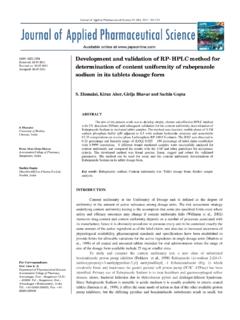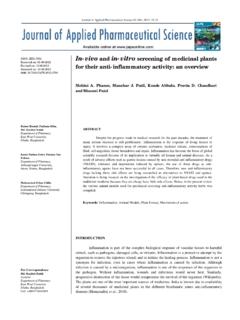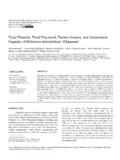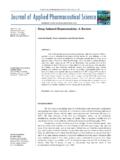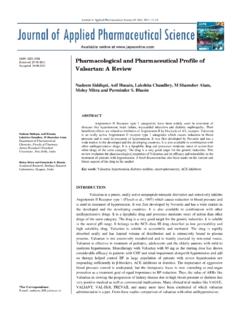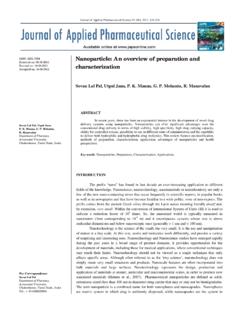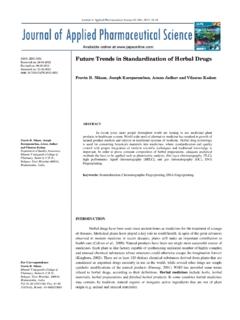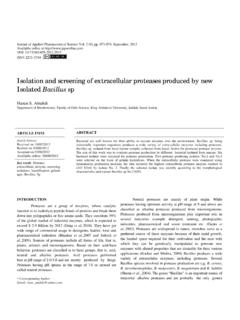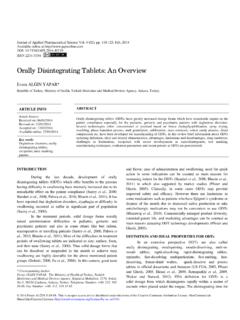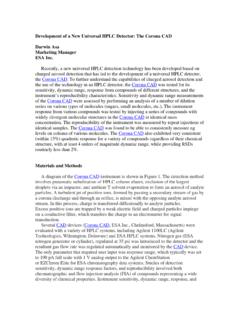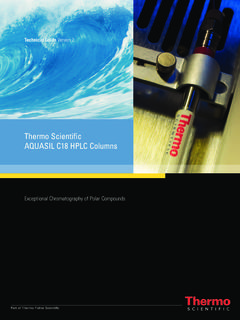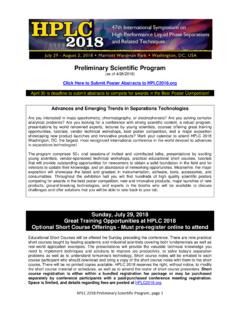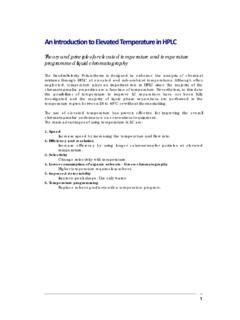Transcription of Quantitative HPLC analysis of phenolic acids, flavonoids ...
1 Journal of Applied Pharmaceutical Science Vol. 6 (02), pp. 157-166, February, 2016. Available online at DOI: ISSN 2231-3354. Quantitative hplc analysis of phenolic acids, flavonoids and ascorbic acid in four different solvent extracts of two wild edible leaves, Sonchus arvensis and Oenanthe linearis of North-Eastern region in India Tapan Seal*. Plant Chemistry Department, Botanical Survey of India, India. ARTICLE INFO ABSTRACT. Article history: A reversed-phase high-performance liquid chromatographic method using photodiode array detector with Received on: 24/11/2015 gradient elution has been developed and validated for the simultaneous estimation of ascorbic acid, free phenolic Revised on: 10/12/2015 acids and flavonoids (catechin, rutin, quercetin, myrecetin, apigenin and Kaempferol) in four different solvent Accepted on: 28/12/2015 extracts of two wild edible leaves of viz.
2 Sonchus arvensis and Oenanthe linearis, collected from North-eastern Available online: 27/02/2016 region in India . The chromatographic separation was carried out on Acclaim C 18 column (5 m particle size,250 x mm), Dionex Ultimate 3000 liquid chromatograph and detection was carried out at three different Key words: wave lengths (272, 280 and 310 nm) using a mobile phase of acetonitrile and 1% aqueous acetic acid solution phenolic compounds ; with gradient elution. The experimental results showed high amount of ascorbic acid in S. arvensis and O. Ascorbic acid; Different Linearis ( and % respectively) and gallic acid ( and respectively) in 1% aq.
3 Acetic acid solvent extracts; Sonchus extract of these two plants. The high percentage of recovery (96-103%), low coefficient of variation ( R2 > ). arvensis; Oenanthe linearis; and low limit of detection (LOD) and limit of quantitation (LOQ) confirm the suitability of the method for Gradient hplc . simultaneous quantification of ascorbic acid and all phenolic compounds in the two plants under investigation. INTRODUCTION acid, a water soluble vitamin is essential nutrient in human diets and found mainly in fruits and vegetables. Due to the remarkable The flavonoids are a large family of polyphenolic antioxidant properties of this compound, it is widely employed in compounds synthesized by plants and structurally derived from pharmaceutical and cosmetic industry and also exerted several the parent substance flavone.
4 flavonoids present in fruits and biological activities (Prabhakar, 2010). phenolic compoundsare leafy vegetables are thought to provide potential and versatile ubiquitous in plants and these are secondary metabolites which health benefits through radical scavenging and chelating activity. shield the plants against UV- radiation or resist the pathogenic The in-vitro antioxidant activities of the flavonoids are due to aggression. their ability to reduce the free radical formation and hence The phenolic acids with common bio-genetic precursor, exhibit several biological activities.
5 Shikimic acid, are mostly found in the bound form and are Many studies have suggested that flavonoids like rutin, classified into three main groups viz. benzoic acid derivative, kaempferol, quercetin, apigenin etc. are well-known for its anti- hydroxycinnamic acid derivative and depsides. These groups are inflammatory, anti-allergic, anti-thrombitic, hepatoprotective, well-known for their analgesic, antipyretic, cholagogic, sedative anti-spasmodic and anticancer properties (Kumar, 2012). Each and anti-biotic properties (Waksmundzka-Hajnos et al., 2007).
6 The different fruits and leafy vegetables are capable to display commonest is hydroxycinnamic acid which consists mainly of different extent of antioxidant activities owing to the presence of ferulic, p-coumaric, caffeic, sinapic acid etc. These acids occur varied amount of free phenolic and flavonol contents. Ascorbic chiefly in the form of ester of quinic acid or glucose . chlorogenic acid. The derivatives of hydroxy benzoic acid include * Corresponding Author vanillic, protocatechuic, p-hydroxy benzoic acid etc. which are E-mail: Tel/FAX : + 91-33-26685771 found predominantly as glycosides.
7 2016 Tapan Seal. This is an open access article distributed under the terms of the Creative Commons Attribution License -NonCommercial-ShareAlikeUnported License ( ). 158 Tapan Seal / Journal of Applied Pharmaceutical Science 6 (02); 2016: 157-166. phenolic acids play a potential protective role against Meghalaya state of India (North-eastern region in India)using different kinds of oxidative damaged diseases through reversed phase hplc with diode array detection. consumption of fruits and vegetables. The amazing antioxidant cum nutraceutical properties of phenolics attracted global attention MATERIALS AND METHODS.
8 Over the past decades. The biological activities like anti- Plant material mutagenicity, anti-bacterial action, anti-viral activity, anti- The leaves of Sonchus arvensis and Oenanthe linearis inflammatory traits, apoptotic actions etc. can only be rationalized were collected from the local market of Meghalaya state of India. by detecting and quantitating such compounds (Mattila, 2007). It It was duly authenticated and a voucher specimen was kept at the is worthy to be noted that only long-term ingestion leads to Department of Plant Chemistry of Botanical Survey of India under mitigation.
9 The Registry No. BSITS 4and BSITS 5 for future reference. The Sonchus arvensis known as Jalynniar/Jakhain in Khasi plant part was shed-dried, made coarse powder and stored in an belongs to the family Compositae. The leaves of this plant are air-tight container for extraction. eaten as salad by the Khasi and Jaintia tribal of north-eastern region in India. It is bitter in taste but its delicacy preferred by the Chemicals local people. The plant is renowned for its sedative, diuretic, The standards chemicals like ascorbic acid, phenolic diaphoretic, antiseptic, hypnotic, expectorant properties and useful acids (gallic, caffeic, syringic, p-coumaric, ferulic, and sinapic), in the treatment of coughs in phthisis, bronchitis, asthma and flavonoids (catechin, rutin, myricetin, quercetin, apigenin and pertussis (Chopra et al.))
10 , 2006). Oenanthe linearis, another wild kaempferol) were purchased from Sigma Chemical Co. (St. Louis, edible plant of the north-eastern region in India, recognized as MO, USA) and the hplc -grade solvents such as chloroform, Jatira by Khasi people, belongs to the family Apiaceae. The young methanol, water and acetic acid were purchased from Merck stems and leaves are cooked or fried as vegetable. The leaves and (Germany). young stems are also boiled and used to cure diarrhea and dysentery. The nutritive value and the antioxidant activities of hplc equipment these plants have already been studied by us.
